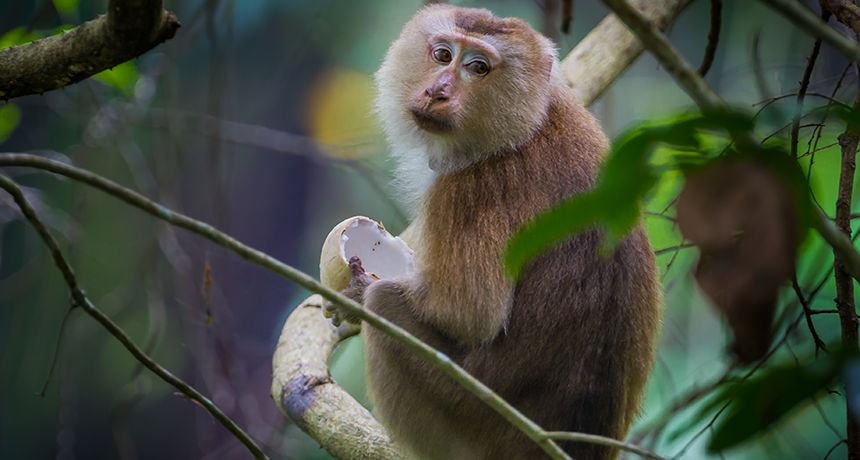Ebola in the air
A deadly virus can spread through the air from pigs to monkeys

Scientists have found that a type of Ebola virus that infects humans can pass from piglets to macaques, like the one shown here, through the air.
kajornyot/iStockphoto
Share this:
- Share via email (Opens in new window) Email
- Click to share on Facebook (Opens in new window) Facebook
- Click to share on X (Opens in new window) X
- Click to share on Pinterest (Opens in new window) Pinterest
- Click to share on Reddit (Opens in new window) Reddit
- Share to Google Classroom (Opens in new window) Google Classroom
- Click to print (Opens in new window) Print
What do you get when you mix six piglets, four monkeys and the deadly Ebola virus? Bad news, according to a recent experiment by Canadian researchers.
The experiment is the first to suggest that the Ebola virus can spread through the air. The study, published in November, detailed how the virus apparently moved from pigs to monkeys without their coming into physical contact. Previously, researchers thought animals had to touch to pass along the virus, which has been blamed for the deaths of more than 1,500 people.
In the experiment, researchers infected six piglets with Ebola by way of a snout injection. The team then placed the infected piglets in a room with several healthy macaques, a type of monkey. A barrier separated the monkeys from the pigs, so the two species could not touch. And yet, after about a week, two monkeys became sick, infected with the virus. A few days later, the other two monkeys also fell sick with Ebola.
The Ebola virus is named for a river in the Democratic Republic of the Congo, in Africa, close to where the germ was discovered. The virus causes high fevers and deadly bleeding disorders in primates, including people and monkeys. It is often fatal. However, scientists previously believed that the virus spread only through direct contact with the blood or other body fluids of an infected person or animal. Other viruses, including the ones that cause chicken pox and the common cold, are known to spread through the air.
Though Ebola too appeared to spread through the air in the laboratory experiment, researchers have not documented any cases of airborne infection under normal conditions. Since the discovery of Ebola in 1976, it has infected more than 2,200 people. Of that total, only 13 people fell ill apparently without coming into direct contact with an infected animal or person. If Ebola spreads easily through the air, scientists and doctors would expect to see more such cases.
“It’s definitely not an efficient route of transmission,” Gary Kobinger told Science News. He is an infectious disease researcher at the University of Manitoba in Winnipeg, Canada, who worked on the new study.
Though the experiment points to airborne transmission, the scientists can’t be 100 percent sure. Water droplets from the infected pigs’ cage may have made contact with the monkeys during cleaning, for example. Nor have researchers seen any cases in Africa where pigs spread the virus to people.
And while researchers still don’t know if the Ebola virus can spread from person to person through the air, they’ll be watching during the next outbreak.
Power Words
virus A tiny molecule made of a protein shell that encloses genetic information. A virus can live and multiply only in the living cells of a host organism, such as humans.
Ebola fever An infectious and generally fatal disease marked by fever and severe internal bleeding. It is caused by the Ebola virus, which spreads from person to person through contact with infected body fluids.
macaque A medium-sized monkey with a long face and cheek pouches. It chiefly lives in forests.







